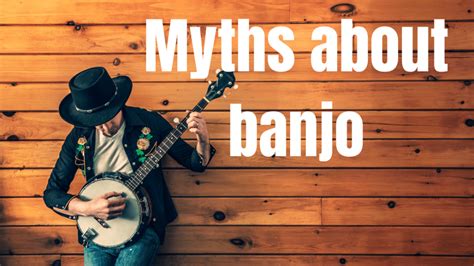The Truth About Banjo Difficulty: No More Myths
The banjo. That iconic instrument, instantly recognizable with its resonant twang, often evokes images of bluegrass mountaintops and spirited folk festivals. But alongside its captivating sound comes a persistent myth: the banjo is incredibly difficult to learn. This article aims to dissect that myth, revealing the truth about banjo difficulty and empowering aspiring players to pick up the instrument without fear.
Is the Banjo Really That Hard to Learn?
The short answer? It's not inherently more difficult than other stringed instruments, but it does present unique challenges. The difficulty isn't universal; it depends on individual factors like musical background, learning style, and dedication. While some aspects might present a steeper learning curve initially, with consistent practice and the right approach, mastering the banjo is entirely achievable.
What Makes the Banjo Seem Difficult?
Several factors contribute to the perception of banjo difficulty:
- Unique Tuning: Banjos are often tuned differently than guitars or other familiar instruments. This unfamiliar tuning can feel awkward at first, requiring time to adjust finger placement and coordination.
- Three-Finger Style: The popular Scruggs-style banjo playing utilizes a complex three-finger picking technique, requiring significant coordination and practice. While a beautiful and powerful style, it's not the only way to play.
- The Roll: The "roll," a fundamental building block of Scruggs style, involves intricate finger movements that take time and deliberate practice to master. It’s the foundation for many complex banjo techniques.
- High String Tension: Banjo strings are generally under higher tension than those on a guitar, making them feel stiffer and potentially causing discomfort for beginners.
H2: What Are the Easiest Banjo Styles to Learn?
Not all banjo styles are created equal. While Scruggs style is incredibly popular, it’s not the easiest starting point for beginners. Here are some gentler introductions to the instrument:
- Melodic Styles: Playing simple melodies, often using a plectrum or fingerpicks, is a great way to learn basic chords and fingerpicking patterns without the complexity of the Scruggs roll.
- Clawhammer Style: Clawhammer is another popular style that uses a simpler, more straightforward picking technique than Scruggs style. It's known for its percussive sound and is a very accessible entry point.
- Beginner Tabs and Songs: Start with easy songs and utilize tablature (tabs) specifically designed for beginners. These resources break down complex techniques into manageable steps.
H2: How Long Does It Take to Learn Banjo?
The time it takes to learn banjo varies greatly. Factors like practice frequency, learning style, and desired skill level all play a significant role. While you might be able to play simple songs within weeks, mastering complex techniques like Scruggs style could take months or even years of dedicated practice. Consistency is key!
H2: What Resources Are Available for Beginners?
Fortunately, many resources are available to support banjo learners:
- Online Lessons: Numerous websites and platforms offer banjo lessons for all skill levels, from beginner to advanced.
- Instructional Books: A wealth of banjo method books cater to different styles and skill levels, providing structured learning paths.
- Local Instructors: Finding a qualified banjo teacher in your area can provide personalized instruction and feedback, accelerating your progress.
H2: Is it Worth the Effort?
Absolutely! The banjo offers a unique and rewarding musical journey. While it presents challenges, the satisfaction of mastering its nuances and creating beautiful music is unparalleled. Don't let the myths dissuade you; with patience, practice, and the right resources, you can unlock the joy of banjo playing.
Conclusion: Embrace the Challenge
The truth about banjo difficulty lies in its unique aspects and the dedication required to master them. However, it's not inherently harder than learning other instruments. By choosing a suitable learning path, utilizing available resources, and practicing consistently, anyone can experience the joy and satisfaction of playing the banjo. So, pick up that banjo, embrace the challenge, and unleash your inner bluegrass musician!

